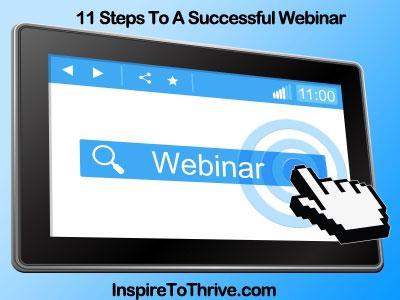Creating A Successful Webinar
 Do you have a website? Maybe also a Facebook page and a Twitter account?
Do you have a website? Maybe also a Facebook page and a Twitter account?
Perfect, you have the internet world at your feet (well, yes, there is also Google Plus).
And if you have many connections, then you have everything you need to create your online empire.
You know that people need to see your face, but it’s not enough to just add your image in your “About Me” blog page.
You can do more, as organizing a webinar, for example, an online seminar focusing on a topic you are expert or passionate about.
It sounds pretty easy, but it is not.
Here are some steps to help you organize a successful webinar.
1. Choose Your Topic
This is the first and most basic step: you need to select an argument for your webinar.
Take your time to reflect, and make sure that the topic is interesting and compelling for your audience.
You can ask the readers of your blog, for example, or set up a survey on your Facebook fan page, or else, send missives on Twitter and Google Plus with a direct question.
You may also want to create a poll with the modules of Google Drive and publish it on your blog (yes, Google Drive can do that too).
2. Plan the Webinar
After choosing a good argument, you need to organize the points to be included in your webinar.
Prepare the material: slides, files, images, videos and any useful links or resources.
Potential participants need to know the program: only in this way, they can evaluate and choose to be present.
And don’t forget to think about the person who will speak (if it won’t be you).
If your webinar will have a certain magnitude, you can ask the help of a team, who can handle the Q & A and engagement with your participants, taking care of specific details.
Planning is important, do not improvise. Give yourself time to think and prepare.
3. Target Accurately

For webinars to be successful, they have to be compelling for the target audience.
Don’t just rely on your own ideas of what information is pertinent; speak with other parties to get fresh content.
Consulting with other experts will add value to your webinars and enhance your contact lists.
Be sure to refine your message as much as possible with the understanding that your audience may not know as much as you do about the subjects you cover and create different webinars to target various groups in your market to ensure that nobody is left out.
4. Select Your Tools
There is a fundamental step you need to take care of: choosing the platform that will host your webinar.
The choice of the webinar software is wide, very wide. And there are many aspects to consider:
- screen sharing;
- number of participants;
- cost;
- presence of a chat feature;
- statistics function;
- recording.
An important tip for creating your slides: use quality images, think about simplicity and explain one concept per slide.
5. Integrate Prospect Information Into Campaigns
Taking note of prospect objectives is essential for webinar success.
By creating polls and enabling attendees to ask questions and make comments throughout your webinars, you’ll have a window into the state of mind of these potential buyers.
For best results, you can put this information into a specialized database and integrate it into your future webinars.
To better target specific attendees, put your data into individual files for these prospects.
6. Combine Data Systems
The last step concerned the collection of data within webinars, but this step involves the integration of webinar data with information collected from other areas.
For best results, create prospect profiles by combining webinar questions and poll answers with site usage information and email interactions.
This also promotes seamless re-engagement when prospects are contacted later for the presentation with new products and services.
7. How Long Should a Webinar Last?
An hour is a good compromise for an interested and lively audience.
You can talk for 45-50 minutes and let the remaining time for questions.
A very important prerequisite is your content.
Remember. It does not make sense to organize 60 minutes for your webinar, when you can manage just 30.
8. Test It
Organize a test and invite a couple of friends.
You must fix any issue you will find in your webinar, and you must do it at least a week before the event date.
You may need to change plans, so it’s better to have a good margin of time available.
The day before you go live run another test, just by yourself. This way, you can correct the latest issues.
9. Start the Right Way

Say hello to the people who log in and try to transmit positivity to the other side of the screen.
Of course, you don’t have to be a clown, but neither a zombie.
And most of all, you must be ready to share your knowledge. Don’t be stingy!
10. Create Drip Campaigns
Webinars are convenient ways to keep users interested until they’re ready to buy.
In order to maintain communication, create a series of helpful webinars that are released according to a posted schedule.
This way, loyal viewers will come back time after time for more valuable information.
For best results, target different levels of buyers with specific balances of technical and generic content.
After several months of drip campaigning, be sure to increase your direct communication with prospects to start engaging them in the buying process.
11. Close The Sale at the End of Your Webinars
At the end of your webinars, give a simple and explicit call to action. Make things simple for your users by telling them what the next step is.
To simplify this step with large numbers of customers, you can use an automated process that utilizes targeted emails based on unique prospect profiles.
In order to enhance future conversions, all efforts should be tracked and modified as necessary for different types of buyers.
A well-executed webinar can be the ticket to attracting and converting potential leads into lifetime clients, and with a wide variety of online streaming media software, they can be fairly affordable to produce.
Conclusion
This is a small and getting started guide to organize and set a webinar.
I’m sure you have some points to add to this article. Maybe because you have already had experience in this field.
So please let me know what you think in the comments below, thanks!
Images courtesy of Stuart Miles at FreeDigitalPhotos.net
- About
- Latest Posts

Erik Emanuelli
Erik is a professional blogger and freelance writer. He loves to skydive and work on his NoPassiveIncome blog (but not at the same time).
Latest posts by Erik Emanuelli (see all)
- 11 Steps to Create a Successful Webinar - March 17, 2015
- Email Marketing: How to Avoid Being Flagged as SPAM - January 17, 2015

